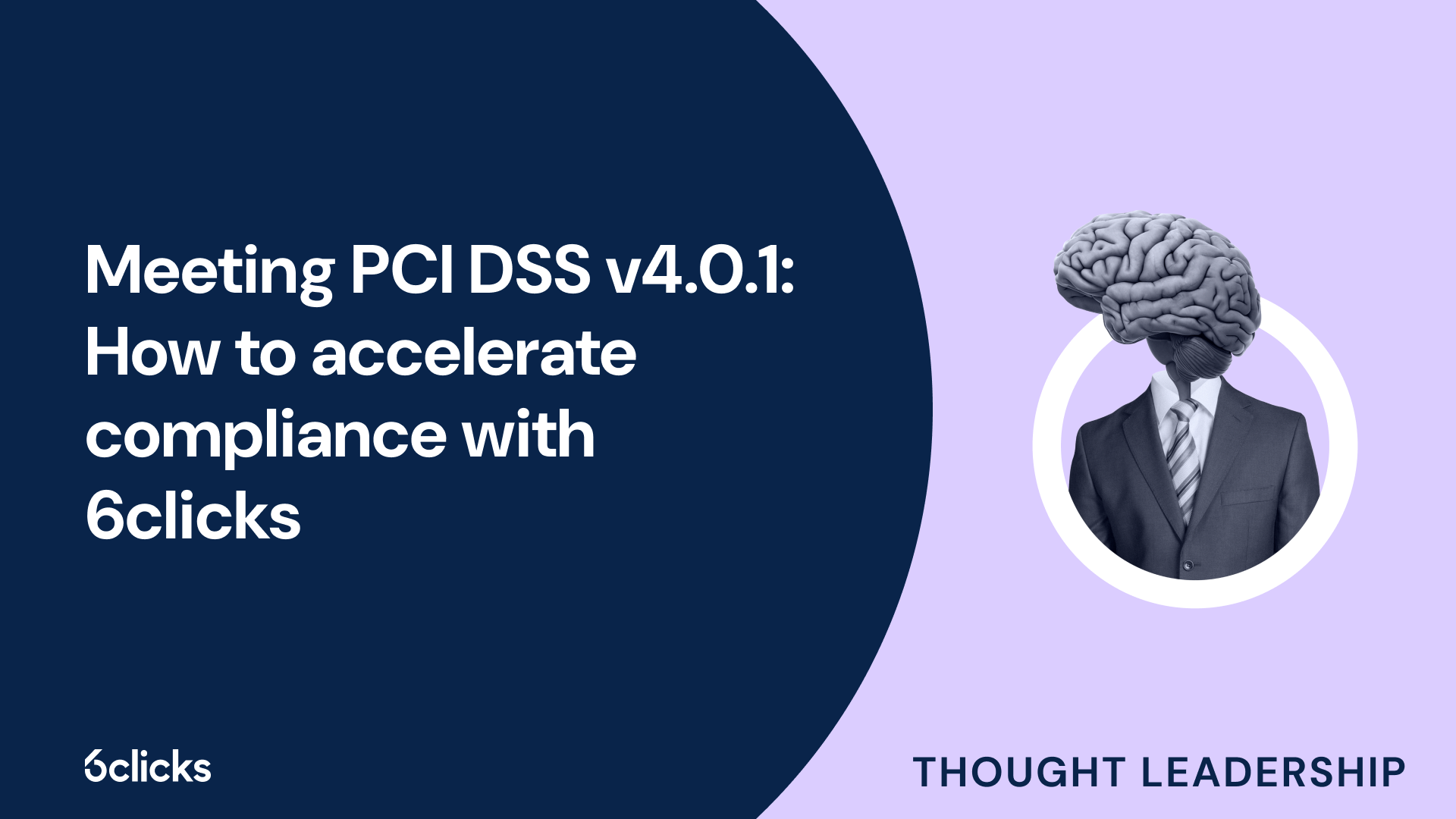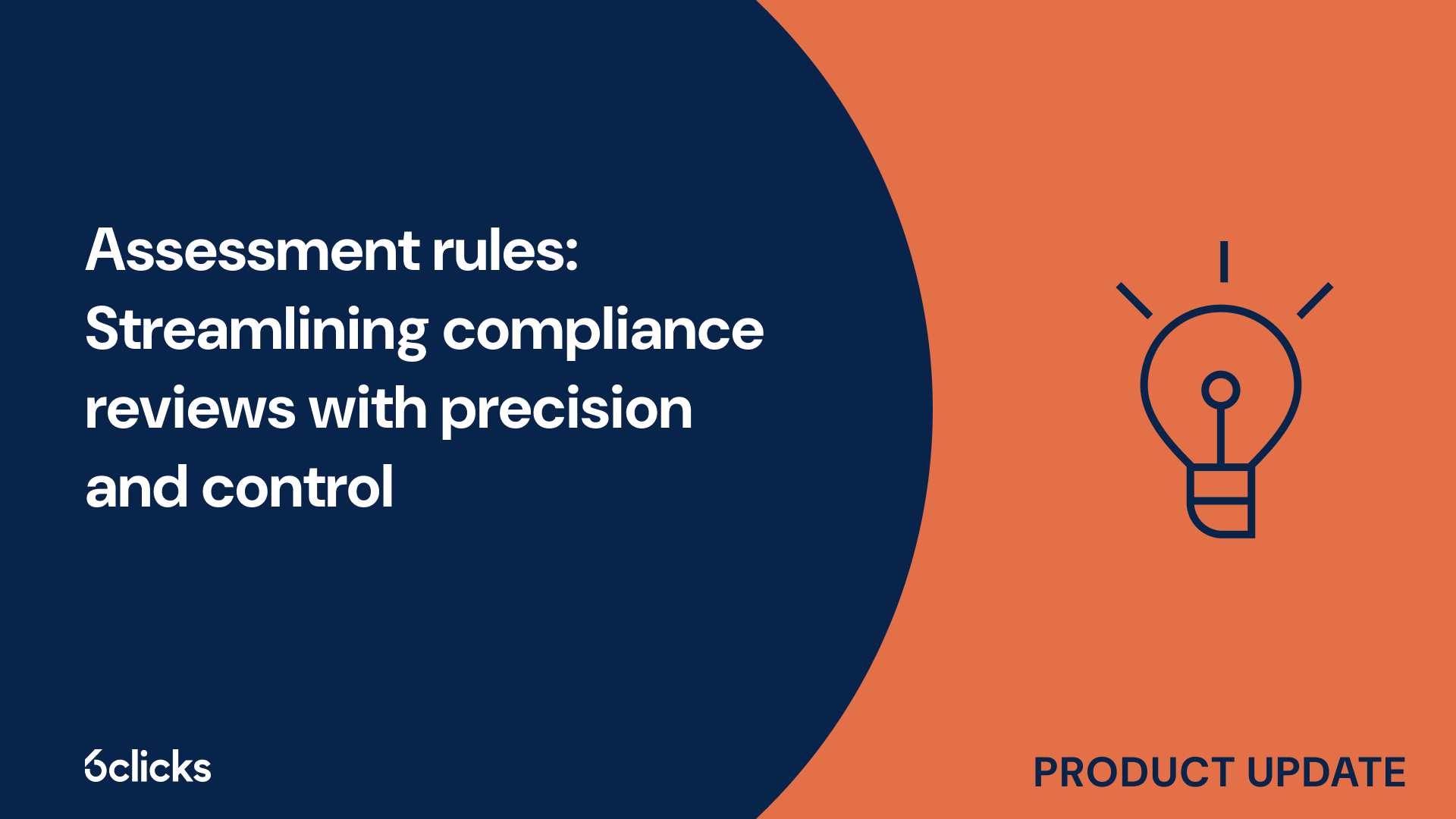The GRC buyer’s guide for 2025: Building resilience with AI-powered, federated solutions
Discover the ultimate GRC buyer's guide for 2025! Uncover how AI-powered, federated solutions transform compliance and security management for industries like government, aerospace, banking, and more. Learn about centralized control, continuous compliance, and advanced cyber GRC capabilities. Download now!
-1.png?width=200&height=249&name=Group%20193%20(1)-1.png)
The GRC buyer’s guide for 2025: Building resilience with AI-powered, federated solutions
What is HITRUST?
HITRUST, which stands for Health Information Trust Alliance, is a certifiable security framework that provides healthcare organizations with a comprehensive approach to managing and protecting sensitive health data. It combines various regulatory requirements, such as HIPAA, with industry best practices to establish a common security framework that can be used by healthcare providers, business associates, and health insurers. HITRUST's Common Security Framework (CSF) is designed to address the complexity of the healthcare industry and ensure the protection of patient health information. It covers various control categories, including administrative, technical, and physical safeguards, and lays out measurable criteria to help organizations assess and improve their security posture. The CSF also includes specific guidance for risk management, privacy, and compliance objectives, and provides a certification process to validate an organization's compliance with the framework. Through its comprehensive and adaptable approach, HITRUST has become a widely recognized and respected standard in the healthcare industry, serving as the gold standard for health information security.
What is HIPAA?
HIPAA, which stands for the Health Insurance Portability and Accountability Act, is a federal law established in 1996 to protect the privacy and security of patient health information. HIPAA applies to covered entities, which include healthcare providers, health plans, and healthcare clearinghouses, as well as their business associates, such as third-party vendors and contractors.
The main purpose of HIPAA is to ensure that patient health information, known as protected health information (PHI), is kept confidential and is only shared with authorized individuals for legitimate healthcare reasons. HIPAA provides regulations and standards that covered entities and business associates must follow to protect PHI. These regulations include requirements for physical and technical safeguards, administrative procedures, and policies to ensure the privacy and security of patient information.
HIPAA strikes a balance between protecting patient privacy and allowing necessary sharing of information for healthcare purposes. While it places strict regulations on how PHI can be used and disclosed, it also allows for the sharing of patient information within the healthcare system for treatment, payment, and healthcare operations. This ensures that healthcare providers have access to the necessary information to provide quality care while respecting individuals' privacy rights.
Difference between HITRUST & HIPAA
HITRUST and HIPAA are both compliance frameworks that aim to protect patient health information in the healthcare industry. However, there are distinct differences between the two.
One key difference is that HIPAA is a government-mandated requirement enforced by the US Department of Health and Human Services, while HITRUST is a third-party compliance framework created by industry experts. HIPAA sets the regulatory standards and provides guidelines for covered entities (healthcare providers, health plans, and clearinghouses) and business associates to protect patient information. On the other hand, HITRUST is a certifiable security framework that merges multiple regulations, such as HIPAA, and industry best practices into a single comprehensive framework.
HITRUST goes beyond HIPAA's requirements by encompassing additional security controls and standards. While HIPAA primarily focuses on protecting electronic health records and addressing privacy concerns, HITRUST includes a broader spectrum of security risks and focuses on the overall security posture of healthcare organizations. This comprehensive approach allows healthcare organizations to address multiple regulatory requirements and align their compliance initiatives with a single framework.
Healthcare industry overview
The healthcare industry plays a vital role in society, providing essential services to individuals in need of medical care. It encompasses a wide range of entities, including healthcare providers, health plans, pharmaceutical companies, and medical device manufacturers. The industry is heavily regulated to ensure the privacy and security of personal health information, and compliance with regulatory standards is crucial. Two important frameworks in the healthcare industry are HITRUST and HIPAA. While HIPAA is a government-mandated requirement that focuses on protecting patient information, HITRUST is a comprehensive security framework that goes beyond HIPAA's requirements to address a broader spectrum of security risks. By understanding the differences between these frameworks, healthcare organizations can ensure they meet the necessary compliance standards and protect sensitive health data.
Overview of the healthcare industry
The healthcare industry plays a vital role in society, ensuring the physical and mental well-being of individuals. With the advancements in technology, the collection, storage, and sharing of personal health information have become increasingly digitalized. To protect patient privacy, the industry must comply with regulatory standards like HIPAA (Health Insurance Portability and Accountability Act) and HITRUST (Health Information Trust Alliance).
HIPAA, enacted in 1996, sets national standards for the security and privacy of electronic protected health information (ePHI). It applies to healthcare providers, health insurers, and other entities that handle patient health data. HIPAA requires these covered entities to follow specific guidelines to safeguard ePHI, including implementing access controls, risk management, and audit controls.
HITRUST, on the other hand, is a certifiable framework that ensures comprehensive security and regulatory compliance for healthcare organizations. It was developed in collaboration with the healthcare industry and the Alliance of Security Industry (ASI). HITRUST CSF (Common Security Framework) incorporates various security controls and standards to address the unique risks faced by healthcare organizations. It provides a robust framework for risk management and ensures that controls are aligned with legal requirements and industry best practices.
Overview of business associates and covered entities
In the healthcare industry, there are two key roles when it comes to the protection of patient health information: covered entities and business associates. Covered entities refer to healthcare providers, health insurers, and other entities that handle patient health data and are directly subject to the requirements of the Health Insurance Portability and Accountability Act (HIPAA).
HIPAA, enacted in 1996, sets national standards for the security and privacy of electronic protected health information (ePHI). Covered entities, such as hospitals and doctors' offices, are obligated to comply with specific guidelines to safeguard ePHI. These guidelines include implementing access controls, risk management, and audit controls to protect patient privacy.
Business associates are individuals or organizations that perform certain functions or activities on behalf of covered entities and require access to patient information. Examples of business associates include medical billing companies, third-party administrators, and IT service providers.
The HITECH Act, passed in 2009, expanded the requirements of HIPAA to include business associates. It made business associates directly liable for complying with certain privacy and security provisions of HIPAA. To ensure the proper handling of protected health information (PHI) by business associates, covered entities are required to have Business Associate Agreements (BAAs) in place. These agreements outline the responsibilities and obligations of both parties in safeguarding PHI and ensure that business associates meet the same HIPAA requirements as covered entities.
Having BAAs in place is crucial in maintaining the privacy and security of patient information. It helps to establish a legal framework that holds business associates accountable for protecting PHI, ultimately ensuring that patient data remains confidential and secure.
Role of HIPAA in the healthcare industry
HIPAA, or the Health Insurance Portability and Accountability Act, plays a vital role in the healthcare industry by ensuring the protection of patient privacy and the security of their health information. It sets national standards for the handling and disclosure of protected health information (PHI) and applies to healthcare providers, health plans, healthcare clearinghouses, and their business associates.
HIPAA requires covered entities, such as hospitals, doctors' offices, insurance companies, and pharmacies, to implement safeguards to protect patient privacy and the integrity of their health information. This includes implementing administrative, physical, and technical security measures to ensure the confidentiality and availability of PHI.
One key aspect of HIPAA is the protection of patient privacy and the requirement for patient consent for the disclosure of their health information. However, there are exceptions to this consent requirement, such as for treatment, payment, and healthcare operations. This allows healthcare providers and organizations to share PHI without obtaining patient consent, as long as it is for purposes directly related to healthcare delivery, billing, or improving the quality of care.
It is important to note that HIPAA does not have a certification process for compliance. Instead, covered entities and business associates are responsible for implementing necessary safeguards and adhering to the standards set by HIPAA. While there is no official certification, organizations can undergo voluntary audits or assessments to demonstrate their compliance with HIPAA regulations.
HITRUST CSF framework overview
HITRUST, or the Health Information Trust Alliance, offers a comprehensive framework known as the HITRUST CSF (Common Security Framework). This framework is designed to address the specific security and compliance needs of the healthcare industry. It combines various regulatory requirements, such as HIPAA and other industry standards, into a single framework that can be used by healthcare organizations and their business associates to ensure the protection of sensitive health information. The HITRUST CSF provides a certifiable security framework that incorporates control objectives, specifications, and criteria for implementing necessary security controls and safeguards. By leveraging the HITRUST CSF, healthcare organizations can enhance their security posture, effectively manage and mitigate security risks, and demonstrate their commitment to regulatory compliance in the healthcare industry.
Definition of the HITRUST CSF framework
The HITRUST CSF (Common Security Framework) framework is a comprehensive and certifiable security standard specifically designed for the healthcare industry. Its purpose is to provide healthcare organizations with a streamlined and centralized approach to managing their security posture and compliance initiatives.
The structure of the HITRUST CSF framework is based on various existing standards, regulations, and business requirements. It incorporates and harmonizes a wide range of controls from frameworks such as HIPAA, NIST, COBIT, and ISO, making it a one-stop solution for healthcare providers, business associates, and covered entities.
Key components of the HITRUST CSF framework include administrative, technical, and physical safeguards to protect personal health information (PHI). It also addresses control categories such as access controls, risk management, and data protection. The framework follows a risk-based approach, allowing organizations to assess their security risks and implement controls based on their unique needs and risk factors.
One of the notable advantages of the HITRUST CSF framework is its scalability. It caters to organizations of all sizes, from small healthcare providers to large health organizations. Moreover, it offers the flexibility to adopt alternate or compensating controls when required, ensuring that organizations can meet regulatory requirements while considering their specific circumstances.
Components of the HITRUST CSF framework
The HITRUST CSF framework brings together multiple security and privacy-related regulations, standards, and frameworks into a unified and comprehensive solution for healthcare organizations. It incorporates controls from well-established frameworks such as HIPAA, ISO, NIST, PCI, and GDPR to address the complex security and compliance needs of the healthcare industry.
The HITRUST CSF framework consists of various components that work together to ensure the protection of personal health information (PHI). It includes administrative, technical, and physical safeguards to establish a strong security posture. Control categories such as access controls, risk management, and data protection are carefully defined and integrated into the framework.
By amalgamating these regulations, standards, and frameworks, the HITRUST CSF framework simplifies compliance for healthcare organizations. It eliminates the need to navigate multiple and sometimes conflicting requirements, saving time and resources. Instead of focusing on multiple compliance initiatives, organizations can use the HITRUST CSF as a comprehensive security framework that aligns with their regulatory objectives.
Additionally, the HITRUST CSF framework provides a standardized and certifiable framework that can be assessed and certified. This gold standard certification gives healthcare organizations the confidence that their security controls meet national standards and legal requirements.
Benefits of using the HITRUST CSF framework
The HITRUST CSF framework offers a multitude of benefits for healthcare organizations in simplifying compliance with multiple regulations and standards. By incorporating various regulatory requirements and industry best practices, the framework provides a comprehensive and consolidated approach to compliance.
One of the key benefits of using the HITRUST CSF framework is that it simplifies the compliance process. Rather than dealing with numerous and sometimes conflicting regulations, healthcare organizations can utilize the framework to align their security controls with the requirements of multiple regulatory standards. This saves time and resources as organizations no longer have to navigate through complex compliance initiatives.
Moreover, the HITRUST CSF framework provides clarity and consistency for organizations. It establishes a common language and set of control specifications, enabling clear communication and understanding between different stakeholders. This promotes greater consistency in implementing security controls and ensures a more unified approach to protecting personal health information.
Another advantage is the scalability of the HITRUST CSF framework. It can be tailored to accommodate organizations of different sizes and risk levels. By incorporating a risk-based approach, the framework allows organizations to prioritize their security measures based on specific risk factors. This ensures that security controls are proportionate to the level of risk faced by the organization, providing a more effective and efficient approach to protecting healthcare information.
Improved security posture
Improved security posture refers to the strengthened defense against cyber-attacks achieved by healthcare organizations through the implementation of technical and physical safeguards. Both HITRUST and HIPAA emphasize the importance of protecting sensitive healthcare information from unauthorized access and disclosure.
Implementing technical safeguards involves the use of secure technology solutions and controls to protect electronic health records (EHRs) and other sensitive data. This includes access controls such as unique user identification and authentication, encryption of data at rest and in transit, and the use of firewalls and intrusion detection systems to monitor and prevent unauthorized access.
Additionally, physical safeguards involve physical measures to protect the physical infrastructure that houses healthcare information. This includes measures such as restricted access to data centers, video surveillance, and secure storage and disposal of physical media.
Adopting a zero-trust security strategy is crucial in today's increasingly interconnected and constantly evolving threat landscape. This approach assumes that no user or device should be automatically trusted, regardless of their location or network credentials. Instead, every access request is thoroughly verified and authenticated before granting access to sensitive data.
The HITRUST CSF Maturity Model promotes a continual improvement approach to security by providing organizations with a roadmap for enhancing their security posture over time. It consists of multiple maturity levels, each representing a higher level of security maturity and readiness. By following this model, organizations can assess their current security posture, identify gaps, and prioritize remediation efforts to continually strengthen their defenses against cyber-attacks.
Increased efficiency and cost savings
The implementation of the HITRUST CSF (Common Security Framework) framework in the healthcare industry can lead to increased efficiency and significant cost savings. This comprehensive framework provides healthcare organizations with a streamlined approach to managing their security and regulatory compliance.
By adopting the HITRUST CSF framework, healthcare organizations can streamline their compliance processes. Rather than undergoing separate assessments for each regulatory standard they must adhere to, organizations can rely on a single assessment process that covers multiple standards, including HIPAA, NIST, and ISO. This not only saves time and resources but also ensures consistency in meeting regulatory requirements.
The HITRUST CSF framework also allows organizations to achieve certification, which serves as a seal of compliance and assurance. This certification demonstrates that the organization has met the rigorous security and privacy requirements outlined in the framework. It provides healthcare organizations with a competitive advantage, as they can quickly prove their commitment to protecting sensitive data to business partners, patients, and regulatory authorities.
Furthermore, the HITRUST CSF framework enables organizations to easily manage third-party risk. Many healthcare organizations collaborate with business associates and other third-party entities that handle sensitive data. By requiring these entities to adhere to the HITRUST CSF framework, healthcare organizations can ensure that their partners are also implementing robust security measures, minimizing the risk of data breaches and potential legal and financial consequences.
Enhanced compliance with regulatory requirements
The HITRUST CSF framework is designed to enhance compliance with regulatory requirements in the healthcare industry. This comprehensive framework harmonizes various regulatory standards, including HIPAA, HITECH, NIST, ISO, COBIT, and PCI, enabling organizations to streamline their compliance management.
By adopting the HITRUST CSF framework, healthcare organizations can attest to multiple regulations through a single assessment process. This simplifies compliance management and saves valuable time and resources. Instead of undergoing separate assessments for each individual regulatory standard, organizations can rely on the HITRUST CSF framework to cover all relevant requirements.
The HITRUST CSF framework provides a robust and consistent set of security and privacy controls, ensuring that organizations meet regulatory requirements. It offers measurable criteria and control specifications that align with national standards and best practices.
With the ability to address multiple regulatory standards, organizations can demonstrate their commitment to compliance and data protection. This not only strengthens their security posture but also provides assurance to business partners, patients, and regulatory authorities.
Improved risk Management & mitigation strategies
Improved risk management and mitigation strategies are crucial in the healthcare industry to ensure the protection of sensitive patient data and comply with regulatory requirements. By implementing a comprehensive risk management plan and conducting regular risk assessments, healthcare organizations can identify and address potential vulnerabilities before they are exploited.
Taking a proactive approach to risk management significantly reduces the likelihood of discovering security gaps or non-compliance during an audit. This approach involves regularly assessing potential risks, implementing appropriate controls, and continuously monitoring and updating security measures. By being proactive, organizations can demonstrate their commitment to data protection and compliance with regulatory standards.
Becoming HITRUST certified offers numerous benefits for healthcare organizations. HITRUST certification provides a comprehensive framework for managing risk, aligning with national standards and best practices. It enables organizations to effectively manage third-party relationships by implementing stringent security controls and verifying their compliance with regulatory requirements. This is especially important as healthcare organizations often rely on business associates to handle sensitive patient data.







